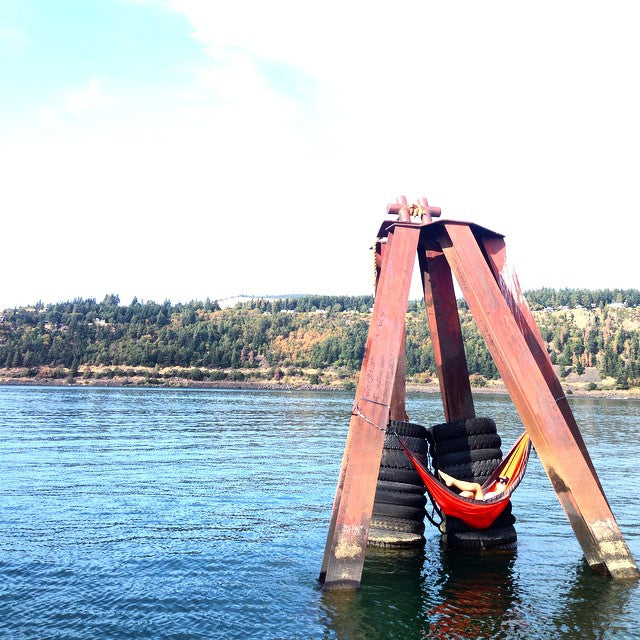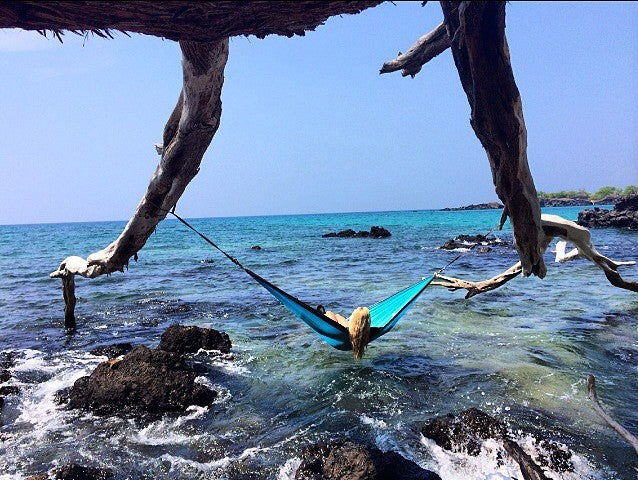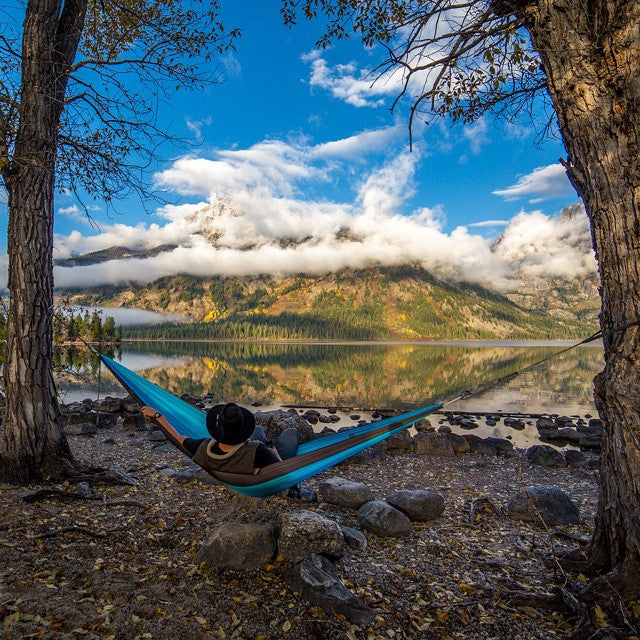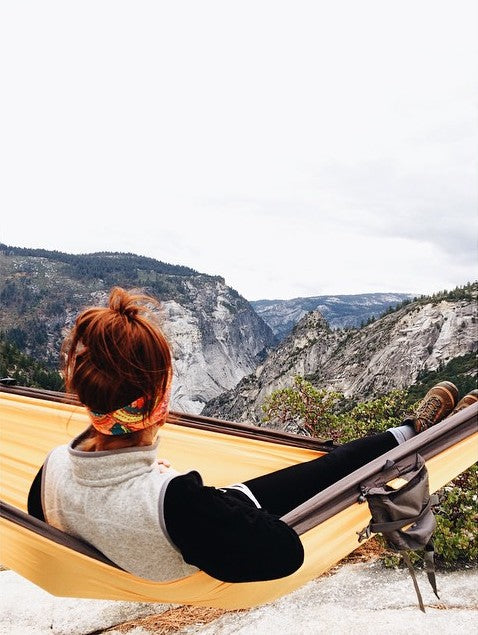Best of #theroolife Sept 22-28th
Here a few amazing images from our hashtag #theroolife.
Make sure you are tagging your Instagram images so that we can repost them from our page!










Here a few amazing images from our hashtag #theroolife.
Make sure you are tagging your Instagram images so that we can repost them from our page!











Austin, TX. (March 7, 2023) — Kammok, designer of high-performance outdoor gear, announced the launch of its latest product, the Ursa Sleep System, on Kickstarter. The Ursa is the ultimate camping bed, offering maximum comfort for more restorative outdoor sleep. The Ursa Sleep System is a comprehensive sleeping solution that promises unapologetic comfort and spaciousness, packed with all the bells and whistles necessary to make camping a memorable and peaceful experience. The sleep system includes a 4" self-inflating base pad, 2" ultra-soft memory foam topper, Primaloft synthetic camp comforter with a 30F degree temperature rating, and a travel case, as well as an upgrade option for a deluxe foam pillow with an adjustable air core. Each component fully integrates to create a single sleep system with unrivaled comfort. The Ursa™ Sleep System is designed to work for any style of sleep, utilizing soft-touch fabrics and superior foam that mimic your bedding at home. The Base Pad features four inches of self-inflating foam, generously sized at L 80 in x W 30 in, providing a spacious surface that allows for full-body movement and comfort. The Ursa’s asymmetrical zippers allow you to link multiple sleep systems together to create a queen-size bed for two or larger, providing more room and comfort for you and your camping companions. The Memory Foam Topper provides a two-inch foam layer that conforms to your body shape, providing support and relief of pressure points. Attached to the topper is Ursa’s insulated hood, made for maximum warmth on colder nights at camp. The Camp Comforter is rated for temperatures as low as 30 degrees and includes a cinchable footbox and top seam when the temperatures drop. Lastly, the oversized pillow features premium memory foam and an adjustable air core to match any sleep position. The Ursa Sleep System is a game-changer for camping enthusiasts, offering the perfect balance of comfort, support, and convenience. "We believe that uncomfortable sleep at camp is a huge barrier for a lot of people wishing to experience the restoration of time outside. The Ursa Sleep System completely changes that, inviting people that wouldn’t traditionally like camping to get joy out and enjoy a night under the stars." said Greg McEvilly, founder, and CEO of Kammok. "The Ursa Sleep System was designed to eliminate any worries about uncomfortable sleeping. Our goal was to create a camp bed that maximized comfort and allowed individuals to fully immerse themselves in nature and make the most of their time outside." Kammok is a company that is passionate about the great outdoors and encourages people to enjoy nature to the fullest. By creating gear that inspires people to spend more time outdoors, Kammok believes it can contribute to the preservation of natural spaces, foster a stronger community, and promote a healthier planet. The launch of Ursa marks Kammok's eleventh Kickstarter project, having successfully funded ten Kickstarter projects since 2011, generating over $2.2 million in pledges. Kammok's commitment to delivering the best quality outdoor gear continues with the launch of Ursa Sleep System. Ursa Sleep System is available exclusively on Kickstarter, starting March 7, 2023.https://www.kickstarter.com/projects/kammok/ursa-sleep-system About Kammok®:Kammok designs Adventure Grade, Better Made™ outdoor gear to elevate time outside. We believe in the renewing power of time spent outdoors, and we make hammocks, insulation, shelters, and hammock stands with the purpose of maximizing your moments of outdoor restoration. Kammok is a member of 1% For The Planet, a Certified B Corp business, a Climate Neutral Certified brand, and every product we make is backed for a lifetime of adventure. To learn more, visit kammok.com.

The Mantis All-In-One Hammock Tent epitomizes sleep versatility. Resort-level comfort and four-season adaptability combine for the most epic hang between two trees. Mantis is adventure ready for basecamp and backcountry, and easily sets up for a backyard nap. This thing can do it all—seriously. “I have taken the mantis out half a dozen times now. It’s become my go to hammock. It’s very well thought out and having a single pack for everything makes it light and small.” - Chuck H., Happy Camper Go-Anywhere Packability It’s time to lighten your load, camper. We know you’re always ready for the next big adventure, and with the Mantis All-In-One Hammock Tent, your kit will be too. The Mantis packs down smaller than your sleeping bag and is lighter than a one-person tent. Don’t need the rainfly or mesh canopy for this trip? Leave one or both at home for an even more compact carry. And when we say the Mantis will go anywhere, we mean it. It’s light enough for overnights in the backcountry, yet comfy enough for daily backyard hangs. Quick, Elevated Setup If you’re tired of trying to find the perfect spot for your tent, level and free of roots and rocks, then the Mantis is your solution. Elevate your campsite and sleep on cloud nine every night. The structural ridgeline takes the guesswork out of setup, providing the ideal hang every time. The knotless design means Mantis goes up in 60 seconds, allowing for more time on the trail and less time fidgeting with cumbersome tent poles. All-Weather Versatility You know what you need better than anyone, so we’re putting you in the driver seat with the Mantis’ versatile design. Take what you need, and leave the rest at home. The detachable Dragonet mesh canopy is essential in mosquito season, and the included rainfly makes for four-season adaptability. Pitch the fly close to the hammock body to stay dry through rain and snow, or use trekking poles for front-porch mode to wake up with a view. No rain in the forecast? Ditch the fly altogether and examine the night sky through the Stargazer panel. Whatever the outdoors throw your way, Mantis has you covered. Designed With the Camper in Mind After a long day on the trail, we know all you want is a comfortable bed to crawl into. The hammock body is made with our signature Gravitas™ fabric—silky soft and luxurious beyond comparison. Storage is a cinch with built-in pockets, and during our Father’s Day Sale, all Mantis purchases come with a free Ridgeline Organizer, giving you even more space for essentials like a water bottle and headlamp. Add one of our trail quilts and our Insulated Pongo Pad for an outdoor oasis like no other—resort level comfort between two trees.

Kammok Outsiders know the feeling of connection that comes from stepping into nature. It’s the first breath of fresh air when we get out of our cars and into the mountains. It’s the audible sigh after jumping into the ocean where all we hear are the rhythmic waves crashing onto white sand beaches. However, there’s no doubt that these spaces and experiences away from our screens are in danger due to climate change. Our commitment to protecting the environment for current and future generations extends beyond Earth Day. We’ve announced our commitment through our partnership with Climate Neutral (read more on it here). We know that for there to be any hope of surviving the climate crisis, we have to take action as both a brand and as individuals. Earlier this month our team at Kammok paused work at the office and hit the trails, but this time we didn’t camp or climb. Instead, we decided to pick up the trash that humans have left behind along a local trail. We spent our day walking the Barton Creek Greenbelt in Austin and picked up a surprising amount of dog poop bags, styrofoam cups and plastic wrappers that were bound to end up contaminating waterways, buried in the soil for hundreds of years or in the stomach of wildlife. For anyone who spends time outside, we urge you to take another look at the seven principles of Leave No Trace. They have great educational resources about the importance of creating minimal impact in wild places. Still have questions or aren’t sure why this is important? Drop us a message on Instagram, we’d love to hear from you! After our team outing on the greenbelt, we decided to get the community involved. For this cleanup, we wanted to hit the streets instead of a trail. So much of the trash that ends up in the wild actually comes from urban areas. With heavy rainfall, winds and waste transportation, a lot of it makes its way to natural areas. We put out an invitation for people in Austin to join us in cleaning up our neighborhood. We set up outside and welcomed new and familiar faces to the Gear Shop for a trashy adventure. We split into two groups and made our way East, trash bags in hand, gloves and grabbers at the ready, we walked along the streets picking up plastic wrappers, cigarette butts, old shoes, rags, glass bottles, and styrofoam. Along our route, we were pleasantly surprised by the number of people who stopped to thank us for picking up trash. People know it’s a problem, it’s a matter of getting out and doing something about it. Protecting our planet is not only an environmental issue but as our founder Greg McEvilly says, is a human issue. It affects our way of life and it’s our responsibility to do something about it. While picking up trash may not be a long-term solution, it’s a small action we can each take in addition to lowering our consumption of single-use products, using alternative modes of transportation, and choosing to support brands that take climate change seriously. At the end of the day, we didn’t just spend a Thursday evening cleaning up trash, but also connecting with people who understand the power of collective action. Thank you to those who showed up for our first community cleanup in Texas. We can’t wait to organize more in the future and expand to other locations. Stay tuned for future events in Austin by following @Kammok_ATX on Instagram.

Another National Camp at Home Day has come and gone, and we can’t say thanks enough to everyone who participated. You wowed us yet again with your creativity. From indoor campfires and starry skies to an actual outdoor igloo, you guys absolutely crushed it. We geeked out over your clever hammock spots and perfectly roasted mallows, but with over 500 campsites globally, more than anything we were in awe of the sense of community that continues to develop around this event. This year, as we focused more on preparedness, we invited a few of our friends to share a bit about hitting the trail, sustainable camping, adventuring with kids, and a whole lot more. Check out our previous blog posts if you haven’t already, and get ready for the camping season! It’s spring here in Texas, with wild flowers blooming and bright green leaves budding from formerly barren trees, and the Kammok team is ready to hit the trail. We hope you’ll do the same. Take the confidence of having just pitched your tent in your backyard or living room, and go check off a new national or state park! This day started as a way to cope with the quarantine blues, but with your help, we hope to build this into a community event for campers who are always learning and preparing for the next big adventure. If you haven’t already, join the conversation on our National Camp at Home Day Facebook group. We created this space for people to learn and get inspired from one another, and as a way to help each other get ready for whatever campsite is calling you next. Share your favorite gear, camping recipes, parks, or whatever gets you excited to be outside with the people you love. Until next year, campers! We’ll see you on the trail.